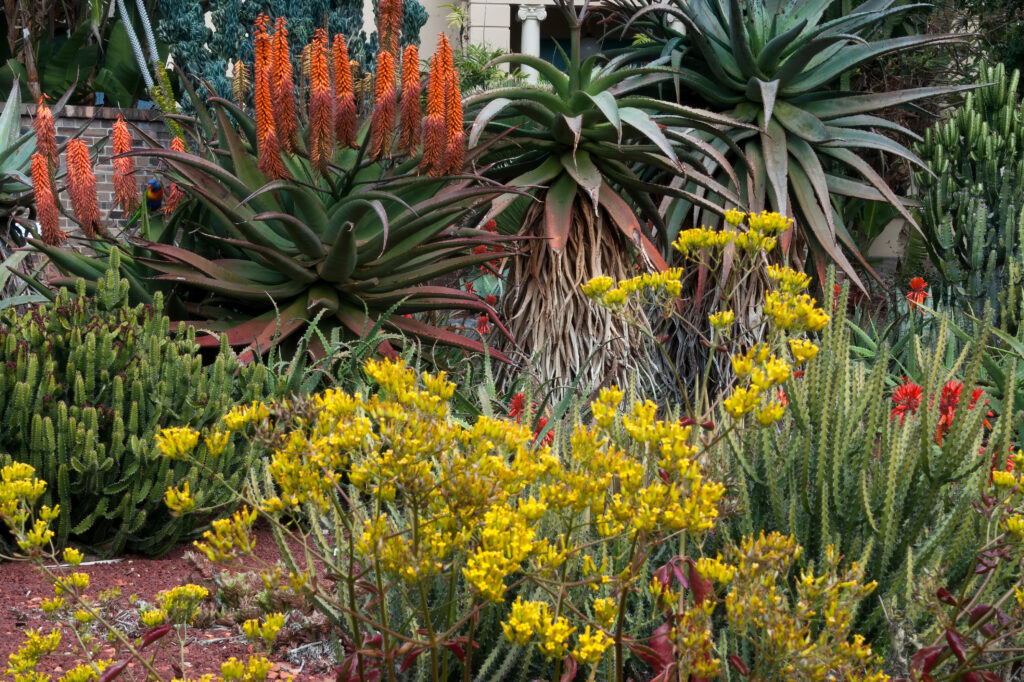Being savvy when it comes to water-smart gardening is more important than ever in today’s world as climate change continues to affect weather patterns and water conservation has become increasingly crucial. Water-smart gardening practices help us to conserve water while not depriving our gardens of such a vital resource. A key component in this is looking at drought-tolerant shrubs. These are not only a great way to conserve water but are very hardy plants and help the local ecosystem in many different ways.
Drought-tolerant shrubs resilience have developed mechanisms to store water more effectively than other plant species to withstand long periods without access to water. This adaptability makes them an asset to any garden providing beauty and structure while requiring little to no maintenance.
Water-smart gardening, also known as xeriscaping, is an approach that focuses on the best way to utilise water resources whilst maintaining a visually appealing and sustainable garden. Xeriscaping involves irrigation planning, plant species research, and soil conservation techniques to create a sustainable and healthy space that makes use of its natural surroundings to conserve water.
Water conservation in landscaping is important for several reasons. Firstly, water scarcity is a major concern for many regions today affected by increased population, climate change, and competing water demands. By reducing the water usage in our gardens, we can help ease that strain on water supplies and contribute to the resilience of ecosystems. Secondly, reducing your water usage at home can be very cost-effective.
Drought-tolerant shrubs are remarkable for their adaptability to harsh conditions, making them a resilient choice for water-smart gardens. Their low water requirement is a desirable feature for water-smart gardens and is possible because of their unique physiological traits. They have deep roots, allowing them to access more moisture deep in the soil, some have waxy leaves that help store water. Once planted, a lot of these types of plants can often naturally thrive on rainfall alone.

When planting, in most cases it is important to acclimate plants to their new soil first to prevent them going into shock. With many Water-smart plants, this is not a step that needs to be taken. These plants have adapted to thrive in a wide range of soil textures, PH levels, and mineral compounds.
These water-smart plants also have a tough resistance to pests and disease. In many cases, they have evolved as a natural defence against most garden pests and pathogens. This means there is less need for chemical intervention when it comes to dealing with garden pesticides and helps promote a more natural healthy garden.
When deciding which water-smart plants to choose from it is important to consider the continued success of your garden. Choosing native species of drought-tolerant plants will help contribute to the biodiversity of the local ecosystem already in place. Look for shrubs that are common in your local area and visit your local nurseries and botanical gardens to help with your research.
With so many species of Water-smart plants to pick from here is a list of our top picks to help get you started, and some of them are more familiar than you think!
Desert Sage (Salvia dorrii): Desert Sage, also known as Purple Sage or Dorrii Sage, is a resilient shrub native to the arid regions of the southwestern United States. It is prized for its aromatic grey-green foliage and striking purple flowers that bloom from spring to early summer, attracting pollinators such as bees and butterflies. Desert Sage is well-adapted to hot, dry conditions and thrives in well-drained soil with full sun exposure.
Texas Ranger (Leucophyllum frutescens): Also known as Texas Sage or Barometer Bush, is a hardy shrub native to the Chihuahuan Desert region of Texas, New Mexico, and northern Mexico. It is characterized by its silver-grey foliage and profusion of purple, pink, or white flowers that bloom after rainfall or high humidity, earning it the nickname “Barometer Bush.” Texas Ranger thrives in hot, dry climates and is exceptionally drought-tolerant once established.
Lavender (Lavandula spp.): Lavender is a versatile and aromatic shrub beloved for its fragrant foliage and delicate purple, blue, or white flowers. While commonly associated with Mediterranean climates, many lavender varieties exhibit excellent drought tolerance and adaptability to various growing conditions. Lavender thrives in full sun and well-drained soil, making it well-suited to water-smart gardens and rockeries.
California Lilac (Ceanothus spp.): California Lilac, also known as Wild Lilac or Mountain Lilac. These shrubs are prized for their vibrant blue, purple, or white flowers that blanket the foliage in spring, creating a stunning display of colour. With their showy blooms and attractive foliage, California Lilacs are popular choices for water-smart gardens and native plant landscapes.
Manzanita (Arctostaphylos spp.): Manzanita is a group of evergreen shrubs native to western North America, known for their distinctive smooth, mahogany-coloured bark and urn-shaped flowers. These drought-tolerant shrubs thrive in sunny, well-drained locations and are particularly well-adapted to rocky or sandy soils. Manzanitas are valued not only for their ornamental qualities but also for their ecological importance, providing habitat and food for wildlife such as birds and pollinators.
Butterfly Bush (Buddleja spp.): Butterfly Bush, also known as Summer Lilac, is a fast-growing shrub prized for its fragrant, nectar-rich flowers that attract butterflies, bees, and other pollinators. Many Buddleja species and cultivars exhibit excellent drought tolerance and adaptability to various growing conditions. These shrubs prefer full sun and well-drained soil and can thrive with minimal irrigation once established.
When planting water-smart plants and shrubs, you will need to do a few things. Firstly, make sure that you prepare the soil before planting to create the optimal growing environment, start with loosening the soil, incorporate organic compost where you can and consider doing a soil test to assess the nutrient levels and pH. Secondly, when planting drought-tolerant shrubs, make sure to follow the proper planting techniques to promote healthy root development. Dig a hole slightly wider and no deeper than the root ball of the shrub. Loosen roots and place them in the center of the hole. Backfill, firming the ground as you go, water and apply mulch.
A lot of these considerations and factors are usually taken care of when being developed by a professional landscaping team. When designing your garden, it’s crucial not only to be considerate of what is possible but to also not feel you have to compromise on your dream outdoor space. That is where Inspired Home and Gardens comes in.
We design, research, plan and create dream gardens and have been doing so since 2017. We want to help develop your garden dreams and aspirations into reality. Whilst we plan your garden we, as a sustainable company, will always try and incorporate as many sustainability practices and encourage you as a client to adopt sustainable elements to your home, without compromising the overall finish of your dream garden.
If you are interested in starting to get your Garden Summer ready, contact us today for more information on how we can help.
